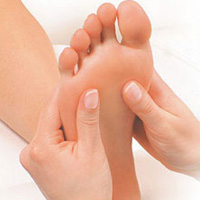You have diabetes? Be careful: if you felt numbness and tingling in the area of brushes or stop, it can be a diabetic polyneeropathy. Read more about this avef in this article.
Content
One of the complications of diabetes mellitus is the defeat of the lower extremities (stop). In this case, occurs «sugar» Vessels and nerves. These changes contribute to a decrease in the sensitivity of the leg and as a result of this easier traumatization, the development of ulcerative defects stop, gangrene. First of all, small vessels and nerves are affected in the lower limbs.
The following form of limb lesions are distinguished:
- angiopathic (with preferably damage vessels);
- neuropathic (with preferably damage to nerve endings);
- Mixed shape.
It should be noted that in diabetes, the sensitivity of the skin is reduced to various external influences, as a result of which cuts, microtraums remain unnoticed. In the future, these wounds can be infected and lead to non-healing ulcers and even gangrene.
To legs are healthy, it is necessary to conduct a number of preventive measures and comply with the rules that allow you to prevent the development of the defeat of stop. Should:
- normalize blood sugar levels;
- regularly conduct surveys with measuring the vibration, temperature, tactile sensitivity;
- on time to carry out treatment.
It is also necessary to comply with such leg care rules:
 Do not warm her legs with hot baths, cock, electrical appliances;
Do not warm her legs with hot baths, cock, electrical appliances;
- do not use sharp objects to care;
- do not use corolla liquid or corn plaster to remove corners, as they contain caustic substances;
- Do not wear close shoes, high-heeled shoes, wearing free leather shoes;
- practice walking barefoot;
- Warm legs with woolen socks;
- Daily wash the legs with warm water, after washing carefully wipe the space between the fingers, use the moisturizing cream with vitamins;
- nails on the legs to pillan in a straight line;
- To remove corners to use pumice;
- Daily make gymnastics for the legs and inspect the legs for damage detection;
- If the wound is detected on the foot, it must be disinfected and stuck with a bactericidal plaster.
The most typical signs of diabetic polyneuropathy - the weakening of the achillov reflexes and the decrease in peripheral vibration sensitivity. The complexity of diagnosis of diabetic polyneuropathy is that, firstly, age changes may produce a similar clinical picture and, secondly, diabetic polyneuropathy can often be asymptomatic and detected only with the so-called electronic studies.
Risk factors for the development of diabetic polyneuropathy
Let us list some risk factors for the development of diabetic polyneuropathy:
- Duration of diabetes
- the age of the patient;
- male gender;
- Higher Growth.
In addition, diabetic polyneeropathy is more common in patients with diabetic retinopathy and nephropathy.









